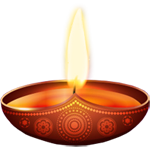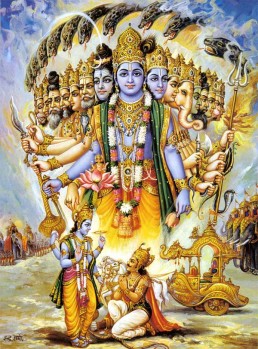Swami Chinmayananda
Swami Chinmayananda Commentary
When the Prince addressed Krishna as the Resplendent (Deva), he is endorsing the comparison of the Lord to the light of thousand-Suns which was used earlier by Sanjaya. Enumerating the features recognised by him on the body of Krishna, Arjuna says, “IN THY BODY I SEE ALL THE DEVAS AND HOSTS OF ALL GRADES OF BEINGS.” This was already indicated by Sanjaya when he described the Universal Form as ‘WEARING NUMEROUS ROBES,’ ‘ADORNING ITSELF WITH DIFFERENT TYPES OF DIVINE ORNAMENTS,’ ‘WEARING GARLANDS OF CELESTIAL BEAUTY,’ and bearing ‘AN ARSENAL OF WEAPONS IN ITS INNUMERABLE HANDS.’These descriptions show that in Krishna one could recognise not only the things of the world, but in the Virata-form of the Lord even the Devas are represented. The same adhidaiva-idea is very directly insisted upon by Arjuna in this stanza when he describes among the things that he saw in Krishna, the Creator, Brahmaji (Brahmaanam), the Annihilator, Shiva (Isham), and the Sustainer, Vishnu (Kamal-asana-stham); along with a host of ancient Seers!
AND CELESTIAL SERPENTS — In poetry, it is a technique, often very effective, employed by great poets wherein they suddenly step down from the sublime to the ridiculous or the grotesque, only to shock the readers and thereby tap out ofthem the degree of special attention which the theme demands. It is indicated here that from Brahmaji in the heavens, to the serpents in the holes of the earth, all are represented in the Lord’s Cosmic-Form. The microcosm (Vyashti) is the macrocosm (Samashti). And this is explained and realised by all great thinkers of the world. But nobody has ever
before tried to express this philosophical idea in the form of a vivid objective representation. Vyasa was the pioneer in this art and none has yet dared to follow him in this arduous task.
THE GRIPPING DETAILS THAT CAN UNNERVE EVEN THE MOST COURAGEOUS ARE GIVEN OUT NOW BY ARJUNA:
Adi Sankara Commentary
Deva, O God; pasyami, I see, perceive; tava dehe, in Your body; sarvan, all; the devan, gods; tatha, as also; bhuta-visesa-sanghan, hosts of (various) classes of beings, groups of moving and non-moving living things having different shapes; and besides, brahmanam, Brahma, with four faces; isam, the Ruler of creatures; kamalasana-stham, sitting on a lotus seat, i.e. sitting on Mount Meru which forms the pericarp of the lotus that is the earth; and sarvan, all; the divyan, heavenly; rsin, sages-Vasistha and others; and (the heavenly) uragan, serpents-Vasuki and others.
The Bhagavad Gita with the commentary of Sri Sankaracharya – Translated by Alladi Mahadeva Sastry
Holy Geeta – Commentary by Swami Chinmayananda
The Bhagavad Gita by Eknath Easwaran – Best selling translation of the Bhagavad Gita
The Bhagavad Gita – Translation and Commentary by Swami Sivananda
Bhagavad Gita – Translation and Commentary by Bhaktivedanta Swami Prabupadha
Srimad Bhagavad Gita Chapter 11 – Verse 15 – 11.15 pasyami devamstava – All Bhagavad Gita (Geeta) Verses in Sanskrit, English, Transliteration, Word Meaning, Translation, Audio, Shankara Bhashya, Adi Sankaracharya Commentary and Links to Videos by Swami Chinmayananda and others – 11-15

